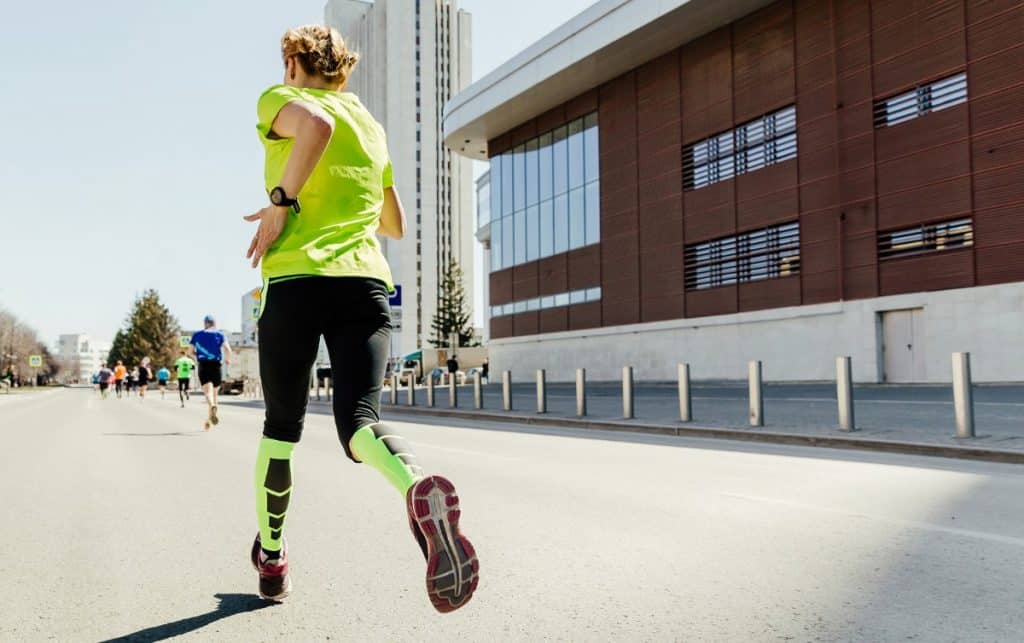A practice race, or tune-up race, is essentially a dress rehearsal for your race – whether that’s a 10K, half marathon, marathon, or ultra.
It’s an opportunity to test out all your strategies and experience a little of what your actual race day will feel like.
This means your morning routine, your start-line warm-up, as well as your fueling, hydration, and pacing strategies can all be road-tested with a practice race beforehand. Before you show up to your practice race, think through each of these elements and have a plan to test them.
A tune-up race also allows you to experience the nerves, anxiety, and adrenaline of race day, so you’re better prepared when it’s time for the main event.

Does a Tune-up Race Need To Be An Actual Organized Race Event?
Ideally, a tune-up race should be a real race.
Why?
Running an actual race event means you’re mimicking the environment of your target race. Therefore, it helps a lot to have things like:
- Looking at race day logistics, getting to the start line, planning your schedule
- Experiencing start-line nerves
- Sticking to your pace strategy when in an actual race
- Planning around fuelling stations, carrying your fuel, and hydration strategy
However, if you can’t find a convenient race for your tune-up, you can do a solo practice race of your own or a virtual race.
How Long Should My Tune-Up Race Distance Be?
In terms of length, a good benchmark is that your practice race should be 50% of your actual race length, or a little more – but shouldn’t be near your race length.
So, for a half marathon, you could complete a 10-15K practice race.
For a full marathon, a half marathon or 30K race would be suitable.

What Pace Should I Run At?
It’s typical to run your practice race at your actual target race pace or close to it.
If you’re aiming for a new PR or ambitious finishing time, running the practice race at your target race pace can serve as a bellwether and give you an indication of how achievable your goals are.
If your goal is simply to finish your race without any specific time-based goal (such as a sub-2-hour half marathon), try and run the practice race at roughly the same rate of perceived exertion or pace you’ll run on race day so you get an idea of how it feels.
Normally, in training, your long runs should be done at a slow, comfortable pace – but the practice race gives you the opportunity to see how it feels to run at a higher rate of exertion for a longer distance.
How Long Before My Goal Race Should I Run My Tune-Up?
Your practice race should ideally take place in the last few weeks of ramping up your training – a week or two before your longest long run and starting your taper.
So, for a half marathon, you’d typically look to do a practice race 3-5 weeks before your event.
For a marathon, you’d want to schedule your practice race 4 -7 weeks before the event.

Tips For Getting The Most Out Of Your Race
#1: Treat the Practice Race as a Dress Rehearsal
A practice race is a great opportunity to do a ‘dress rehearsal’ – this means running your practice race in exactly the same gear as you plan to run your main event.
Same running shoes, shirt, vest, socks . . . sometimes, chafing or discomfort only manifests after running hard for a long time. So, use your practice race to uncover any snags with your gear before race day.
The same goes for the use of lubricants such as Bodyglide or sticking Elastoplast on your nipples – try it out on your practice race first.
#2: Mimic Actual Race Day Conditions
If possible, you want to pick a practice race that mimics the conditions of your actual race as closely as possible.
This means the start time, gradients, the underfoot terrain, as well as the temperature and weather conditions . . . all of these play a part in both your approach and your performance, so being able to mimic race day conditions will go a long way in helping you prepare.
#3: Allow Time For Recovery
Finally, if you’re planning to run your practice race at your target race pace, it’s worth highlighting that this is probably the most challenging run in all your training–so allow yourself the necessary time to recover before resuming your training plan.

Questions To Reflect On Your Practice Race
These are some questions I always ask myself and reflect upon after my practice race to help me prepare for the main event:
- Did I give myself enough time to get ready on the morning of the race?
- Did I eat far enough in advance before the race, or was my breakfast sloshing around as I ran?
- How did I feel at the start line? Was I too cold? Would it be worth taking an extra layer to stay warm on race day?
- How long before the race start did I need to use the bathroom?
- Did the adrenaline at the start line cause me to go out too fast? How did my race pace feel? Do I think it’s realistic that I can hold it for the rest of the distance in my target race?
- How did my energy gels (or other race nutrition) sit in my stomach?
- How did my shoes and gear feel towards the end of the race? Any issues with chafing or blisters?
Reflecting on these questions will help you make the necessary adjustments so you can count on having an awesome race!
If you need some help putting together your fueling strategy, check out this next guide:












